-

人教版高中英语必修1English around the world说课稿
(3)v. 给:提出;展现,显现present sb. with sth. ; present sth. to sb. 把. . 交给;颁发;授予present sth. (for sth. )/present sth. to sb. e. g. Om his birthday, his friends presented him a collection of stamps. 在他生日时,他的朋友们送给他一套邮票作为礼物。The sword was presented by the family to the museum. 这家人把宝剑捐赠给了博物馆。The committee will present the final report to Parliament in June. 委员会将在六月向议会提交最后的报告。You need to present yourself better. 你需要更善于展现自己。It is essential that we present a united front. 至关重要的是我们要表现得更加团结。Step 4 ConsolidationT:Now that we have got a general idea of these words and phrases. Lets make up some sentences using them to master them. Suggested sentences:1. Your duties include typing letters and answering the telephone. 2. It is one of the greatest roles that she has played. 3. A large number of people have applied for the job. 4. The number of the panda is declining. 5. I'11 go there, even if I have to walk. 6. He came up to me to ask for a light. 7. The novel is about a family who can't communicate with each other. 8. He based his plan on interests of most people. 9. Why doesn't he make use of his singing talent?Step 5 Summary and homeworkT:Today we dealt with several new words and phrases. After class I hope that youcan read them again and again to keep them in mind. That's all for today. You aredismissed.
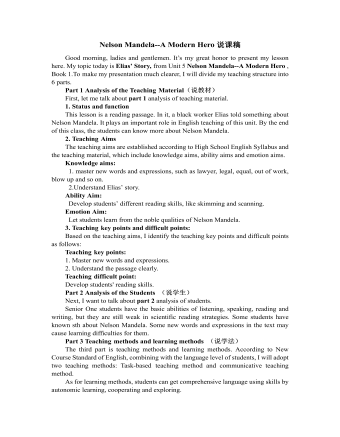
人教版高中英语必修1Nelson Mandela--A Modern Hero说课稿
In this step, give students a few minutes to read the passage . While they are reading, I will write some key words of the text on the blackboard. Then ask students to retell the passage according to the key words.By retelling, students can improve their ability of language organization and have an overall understanding of the article.Step 4 Group discussionIn this step, students will be divided into groups of 4 to discussion the following question: What qualities make a great person?After their discussion, invite a few groups to make a report to the class.This group discussion can practice students’ oral English and cultivate their abilities of cooperation and communication.Step 5. HomeworkLet students write a short passage to introduce a great person he or she admires.The homework can consolidate the knowledge the students have learned and cultivate their writing ability. Part 6 Blackboard Design(板书设计)That’s all my teaching procedures. Finally, I’d like to say sth about part 6 blackboard design. On the top is the title. On the left, there will be some new words and expressions. In the middle of the blackboard, I will write some useful sentence structures so that the students can know clearly what they’ve learned and then try to master the knowledge.OK. That’s all for my presentation. Thank you for your attention.
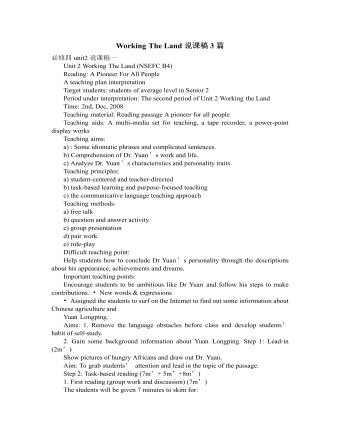
人教版高中英语必修4Working The Land说课稿3篇
Knowledge objectives:(1) to make Ss grasp the usage of words, expressions and sentence structures: statistics, struggle, thanks to, rid of, some patterns for persuasion, the “ing” form as subject and object;(2)to use learnt knowledge to persuade sb.Ability objectives:(1) to develop Ss’ reading skills(skimming, scanning, word guessing);(2) to improve Ss’ speaking, communicating and cooperating skills.Emotional objectives:to make Ss know the contribution of Yuan,and learn his spirit and his simple life time.Teaching important and difficult points:(1) some words, expressions and sentence structures mentioned above;(2)the content of the text;(3)training their reading and speaking skills.Teaching methods: CLT, TBLT,QT.Learning strategies: CLS, QLS, TBLS.Teaching procedures:Step 1 lead-in: (1) teacher plays a piece of recent news from CCTV about the harvest of the super hybrid rice, and ask students whether they know Yuan or not, and talk about him and his contribution.(2)Brain storm: let Ss describe Yuan in their minds including his appearance, his living condition and so on.Step 2 fast reading tasks:(1)teacher introduces Yuan and super hybrid rice(2)make Ss read the text as fast as possible with questions. Such as: what’s the general ideaof this passage? What’s Yuan’ dream? (skimming and scanning skill)Step 3 intensive reading tasks(1)let Ss read the text silently, find topic sentence of each paragraph and draw the difficult sentences and the knowledge what they don’t understand.(words guessing)(2)teacher and Ss talk about the important words, expressions and sentences together, and ask Ss to retell the content of the text.(summarizing and paraphrasing)(3)teacher summarize this part.(4) read again following the courseware.
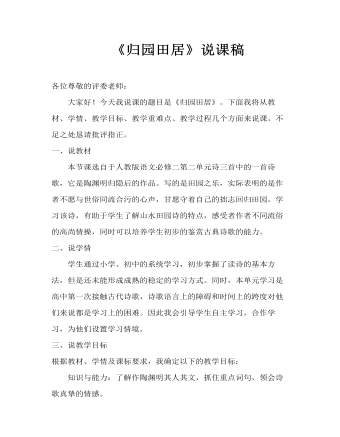
高中语文人教版必修二《归园田居》说课稿
一、说教材本节课选自于人教版语文必修二第二单元诗三首中的一首诗歌,它是陶渊明归隐后的作品。写的是田园之乐,实际表明的是作者不愿与世俗同流合污的心声,甘愿守着自己的拙志回归田园。学习该诗,有助于学生了解山水田园诗的特点,感受者作者不同流俗的高尚情操,同时可以培养学生初步的鉴赏古典诗歌的能力。
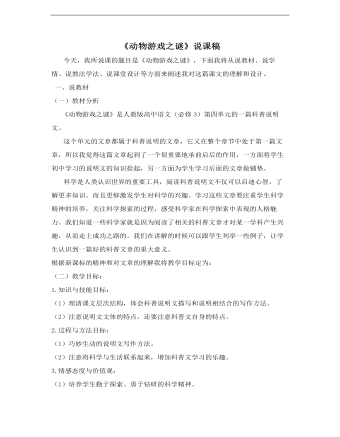
高中语文人教版必修三《动物游戏之谜》说课稿
科学是人类认识世界的重要工具,阅读科普说明文不仅可以启迪心智,了解更多知识。而且更够激发学生对科学的兴趣。学习这些文章要注重学生科学精神的培养,关注科学探索的过程,感受科学家在科学探索中表现的人格魅力。我们知道一些科学家就是因为阅读了相关的科普文章才对某一学科产生兴趣,从而走上成功之路的。我们在讲解的时候可以跟学生列举一些例子,让学生认识到一篇好的科普文章的重大意义。

人教版高中政治必修4在实践中追求和发展真理说课稿(二)
一、教学理论依据及设计理念以新课程理念和新课标为指针,依据建构主义理论、学科探究理论和多元智力理论,采用探究式的教学模式来组织实施本节课的教学。学生成为课堂的主体和知识的主动构建者。通过创设多种情境,让学生积极参与、体验、感悟,主动获得新知,并逐步提高学生发现问题、分析问题和解决问题的能力。教师从课堂的主宰变为课堂的主导,是学生学习活动的组织者、引导者和合作者。教学过程是一个发散式的学生自主学习的过程。采用自主、合作、探究式的教学方式,让学生有多元选择,激发他们的潜能,发展他们的个性。二、教材分析1.教材的地位与作用:本框题是《生活与哲学》第二单元《探索世界与追求真理》第六课“求索真理的历程”的第二节内容。本单元的核心问题是如何看待我们周围的世界,该问题也是《生活与哲学》整本书的核心问题之一。
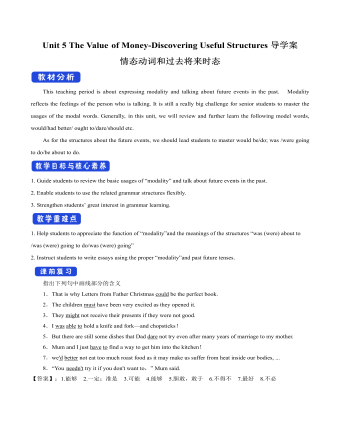
新人教版高中英语必修3Unit 5 The Value of Money-Discovering Useful Structures导学案
4.They were going to find someone to take part in their bet when they saw Henry walking on the street outside.[归纳]1.过去将来时的基本构成和用法过去将来时由“would+动词原形”构成,主要表示从过去某一时间来看将要发生的动作(尤其用于宾语从句中),还可以表示过去的动作习惯或倾向。Jeff knew he would be tired the next day.He promised that he would not open the letter until 2 o'clock.She said that she wouldn't do that again.2.表示过去将来时的其他表达法(1)was/were going to+动词原形:该结构有两个主要用法,一是表示过去的打算,二是表示在过去看来有迹象表明将要发生某事。I thought it was going to rain.(2)was/were to+动词原形:主要表示过去按计划或安排要做的事情。She said she was to get married next month.(3)was/were about to+动词原形:表示在过去看来即将要发生的动作,由于本身已含有“即将”的意味,所以不再与表示具体的将来时间状语连用。I was about to go to bed when the phone rang.(4)was/were+现在分词:表示在过去看来即将发生的动作,通常可用于该结构中的动词是come,go,leave,arrive,begin,start,stop,close,open,die,join,borrow,buy等瞬间动词。Jack said he was leaving tomorrow.
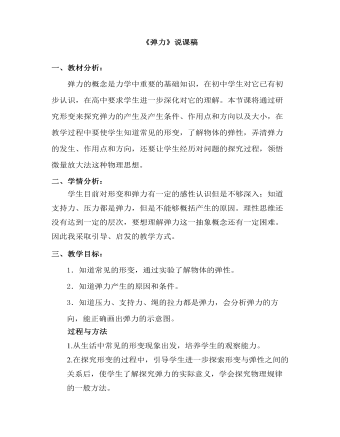
高中物理人教版必修一《弹力》说课稿
二、学情分析:学生目前对形变和弹力有一定的感性认识但是不够深入;知道支持力、压力都是弹力,但是不能够概括产生的原因。理性思维还没有达到一定的层次,要想理解弹力这一抽象概念还有一定困难。因此我采取引导、启发的教学方式。
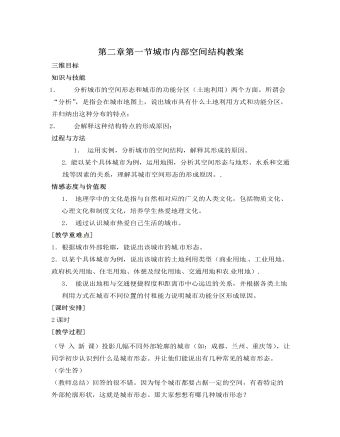
人教版新课标高中地理必修2第二章第一节城市内部空间结构教案
为城市居民提供休养生息的场所,是城市最基本的功能区.城市中最为广泛的土地利用方式就是住宅用地.一般住宅区占据城市空间的40%—60%。(阅读图2.3)请同学讲解高级住宅区与低级住宅区的差别(学生答)(教师总结)(教师讲解)另外还有行政区、文化区等。而在中小城市,这些部门占地面积很小,或者布局分散,形成不了相应的功能 区。(教师提问)我们把城市功能区分了好几种,比如说住宅区,是不是土地都是被居住地占据呢?是不是就没有其他的功能了呢?(学生回答)不是(教师总结)不是的。我们说的住宅区只是在占地面积上,它是占绝大多数,但还是有土地是被其它功能占据的,比如说住宅区里的商店、绿化等也要占据一定的土地, 只是占的比例比较小而已。下面请看书上的活动题。
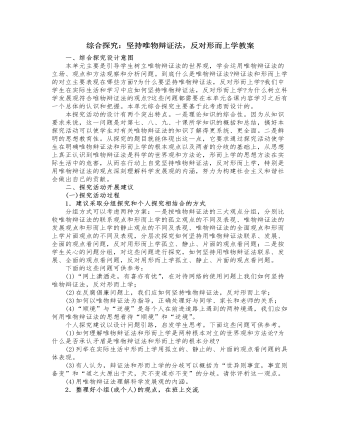
人教版高中政治必修4综合探究:坚持唯物辩证法,反对形而上学教案
5.循环经济当前,发展循环经济和知识经济已成为国际社会的两大趋势,有的发达国家甚至以立法的方式加以推进。循环经济本质上是一种生态经济,它要求运用生态学规律而不是机械的规律来指导人类社会的经济活动,减量化、再利用和资源化是其三大原则。传统经济是一种“资源——产品——污染排放”单向流动的线性经济,特征是高开采、低利用、高排放;与之不同,循环经济倡导的是一种与环境和谐的经济发展模式,它要求把经济活动组织成一个“资源——产品——再生资源”的反馈式流程,特征是低开采、高利用、低排放。目前,我国已经把发展循环经济作为编制“十一五”规划的重要指导原则。6.当心被优势“绊倒”有三个旅行者同时住进一家旅店,早上同时出门旅游。晚上归来时,拿伞的人淋得浑身是水,拿拐杖的人跌得满身是伤,而什么也没有带的人却安然无恙。
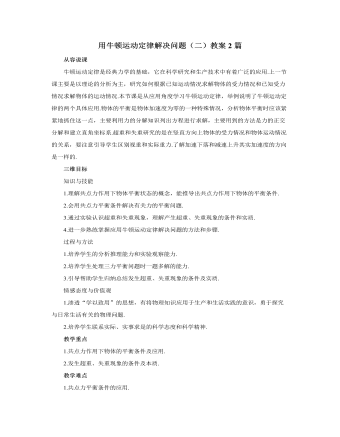
人教版新课标高中物理必修1用牛顿运动定律解决问题(二)教案2篇
观察实验视频实验验证师:其实大家完全可以利用身边的器材来验证。实验1、用弹簧秤挂上钩码,然后迅速上提和迅速下放。现象:在钩码被迅速上提的一瞬间,弹簧秤读数突然变大;在钩码被迅速下放的一瞬间,弹簧秤读数突然变小。师:迅速上提时弹簧秤示数变大是超重还是失重?迅速下放时弹簧秤示数变小是超重还是失重?生:迅速上提超重,迅速下放失重。体会为何用弹簧秤测物体重力时要保证在竖直方向且保持静止或匀速实验2、学生站在医用体重计上,观察下蹲和站起时秤的示数如何变化?在实验前先让同学们理论思考示数会如何变化再去验证,最后再思考。(1)在上升过程中可分为两个阶段:加速上升、减速上升;下蹲过程中也可分为两个阶段:加速下降、减速下降。(2)当学生加速上升和减速下降时会出现超重现象;当学生加速下降和减速上升时会出现失重现象;(3)出现超重现象时加速度方向向上,出现失重现象时加速度方向向下。完全失重
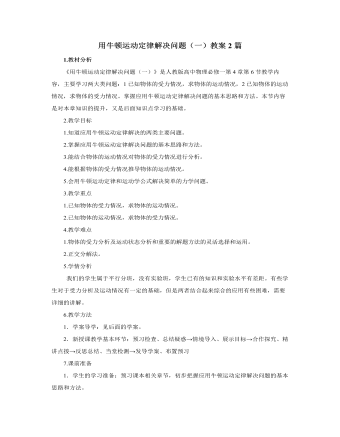
人教版新课标高中物理必修1用牛顿运动定律解决问题(一)教案2篇
(四)实例探究☆力和运动的关系1、一个物体放在光滑水平面上,初速为零,先对物体施加一向东的恒力F,历时1秒,随即把此力改变为向西,大小不变,历时1秒钟,接着又把此力改为向东,大小不变,历时1秒钟,如此反复只改变力的方向,共历时1分钟,在此1分钟内A.物体时而向东运动,时而向西运动,在1分钟末静止于初始位置之东B.物体时而向东运动,时而向西运动,在1分钟末静止于初始位置C.物体时而向东运动,时而向西运动,在1分钟末继续向东运动D.物体一直向东运动,从不向西运动,在1分钟末静止于初始位置之东☆牛顿运动定律的应用2、用30N的水平外力F,拉一静止放在光滑的水平面上质量为20kg的物体,力F作用3秒后消失,则第5秒末物体的速度和加速度分别是A.v=7.5m/s,a=l.5m/s2B.v=4.5m/s,a=l.5m/s2C.v=4.5m/s,a=0D.v=7.5m/s,a=0
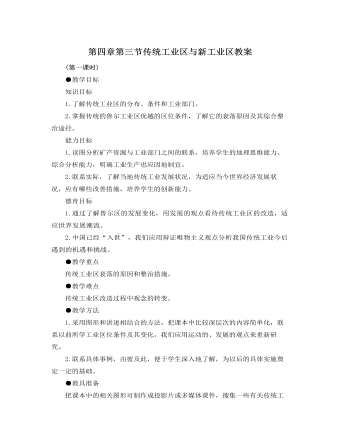
人教版新课标高中地理必修2第四章第三节传统工业区与新工业区教案
知识目标1.了解传统工业区的分布、条件和工业部门。2.掌握传统的鲁尔工业区优越的区位条件,了解它的衰落原因及其综合整治途径。能力目标1.读图分析矿产资源与工业部门之间的联系,培养学生的地理思维能力、综合分析能力,明确工业生产也应因地制宜。2.联系实际,了解当地传统工业发展状况,为适应当今世界经济发展状况,应有哪些改善措施,培养学生的创新能力。德育目标1.通过了解鲁尔区的发展变化,用发展的观点看待传统工业区的改造,适应世界发展潮流。2.中国已经“入世”,我们应用辩证唯物主义观点分析我国传统工业今后遇到的机遇和挑战。

高中历史人教版必修一《马克思主义的诞生》说课稿
一、教学理念在新课改精神指导下,我在本课教学中力求贯彻以下教学理念:新课标的指引观 、生本位的学生观、探究式的学习观、多角色的教师观、 发展性的评价观二、教材地位《马克思主义的诞生》是人教版必修一第五单元第18课内容,本课讲述的是国际共产主义运动范畴的历史,是人类社会进入一个新的发展时期。从总体上概述了社会主义从空想到科学,从理论到实践的历程。说明了科学社会主义理论是历史发展的必然结果。本课在国际工运史上占有重要的地位。通过学习学生可对马克思主义加深了解,理解人类历史发展的必然趋势以及人类一直不断追求进步的精神,帮助学生树立正确的人生观、价值观,达到以史鉴今,服务现实的目的。
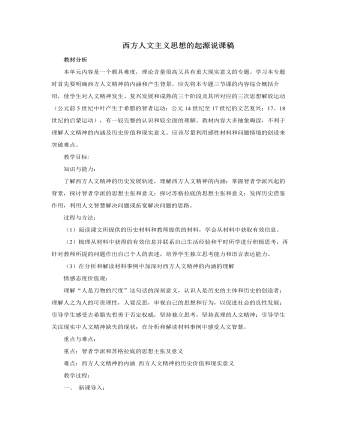
人教版高中历史必修3西方人文主义思想的起源说课稿
苏格拉底把装有毒酒的杯子举到胸口,平静地说:“分手的时候到了,我将死,你们活下来,是谁的选择好,只有天知道。”说毕,一口喝干了毒酒。(2) 苏格拉底临死前对一个叫克力同的人说了这样一番话。克力同,我告诉你,这几天一直有一个神的声音在我心中晓喻我,他说:“苏格拉底,还是听我们的建议吧,我们是你的卫士。不要考虑你的子女、生命或其他东西胜过考虑什么是公正。……事实上你就要离开这里了。当你去死的时候,你是个牺牲品,但不是我们所犯错误的牺牲品,而是你同胞所犯错误的牺牲品。但你若用这种可耻的方法逃避,以错还错,以恶报恶,践踏你自己和我们订立的协议合约,那么你伤害了你最不应该伤害的,包括你自己、你的朋友、你的国家,还有我们。到那时,你活着面对我们的愤怒,你死后我们的兄弟、冥府里的法律也不会热情欢迎你;因为它们知道你试图尽力摧毁我们。别接受克力同的建议,听我们的劝告吧。”
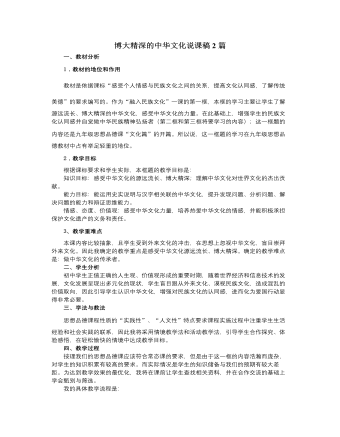
人教版高中政治必修3博大精深的中华文化说课稿2篇
板书:多民族文化对中华文化的意义师:中华民族是多民族的共同体,中华文化呈现多种民族文化的丰富色彩。中华各民族的文化,既有中华文化的共性,又有各自的民族特性。它们都是中华文化的瑰宝,都是中华民族的骄傲。各兄弟民族文化相互交融、相互促进,共同创造了中华文化。各族人民对共同拥有的中华文化的认同感和归属感,显示了中华民族厚重的文化底蕴和强大的民族凝聚力。问题探究8温家宝总理在美国会见华侨时满怀深情地说,中国已解决了香港问题和澳门问题,洗刷了百年耻辱,现在剩下一个台湾问题,“这一湾浅浅的海峡是我们最大的乡愁、最大的国殇”。用有关知识分析:为什么“这一湾浅浅的海峡是我们最大的乡愁、最大的国殇”?生1:台湾是中国的一部分,台湾各族人民是中华民族的一部分,台湾文化归属于中华文化。生2:传统的民族文化是维系民族生存和发展的精神纽带。
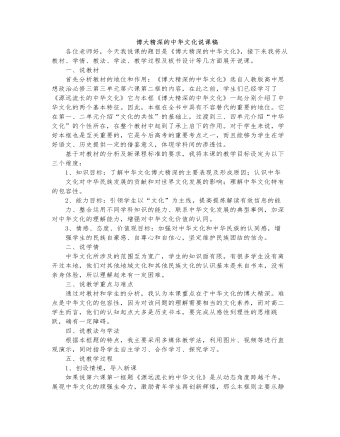
人教版高中政治必修3博大精深的中华文化说课稿
环节三:多媒体继续展示石窟艺术、民族文学等,学生在感受少数民族文化成就的过程中不难得出结论:各民族文化都为中华文化作出了重要贡献,都是中华民族的骄傲。由此进入第三目“中华之瑰宝,民族之骄傲”。各族人民对中华文化的认同感和归属感,显示了中华民族厚重的文化底蕴和强大的民族凝聚力。环节四:合作探究中华文化博大精深的原因。学生调动已有历史知识储备和课前搜集的材料分组交流:历史上在思想文化方面,对诸家学说所采取的兼收并蓄的学术主张;中国文化长期吸收周边少数民族的哪些优秀文明;在对待外域文化上,中华民族是否敞开博大胸怀扬弃吸收。2、从现代找出能充分体现中华民族的文化开放心态和中华文化非凡融合力的例子。这样可增添几分时代气息,更好地服务于当下实践。
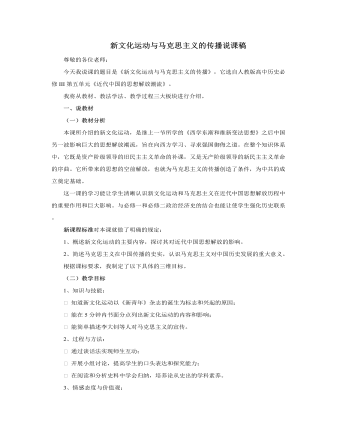
人教版高中历史必修3新文化运动与马克思主义的传播说课稿
一、说教材(一)教材分析本课所介绍的新文化运动,是继上一节所学的《西学东渐和维新变法思想》之后中国另一波影响巨大的思想解放潮流,旨在向西方学习、寻求强国御侮之道。在整个知识体系中,它既是资产阶级领导的旧民主主义革命的补课,又是无产阶级领导的新民主主义革命的序曲。它所带来的思想的空前解放,也就为马克思主义的传播创造了条件,为中共的成立奠定基础。这一课的学习能让学生清晰认识新文化运动和马克思主义在近代中国思想解放历程中的重要作用和巨大影响。与必修一和必修二政治经济史的结合也能让使学生强化历史联系。新课程标准对本课就做了明确的规定:1、概述新文化运动的主要内容,探讨其对近代中国思想解放的影响。2、简述马克思主义在中国传播的史实,认识马克思主义对中国历史发展的重大意义。根据课标要求,我制定了以下具体的三维目标。
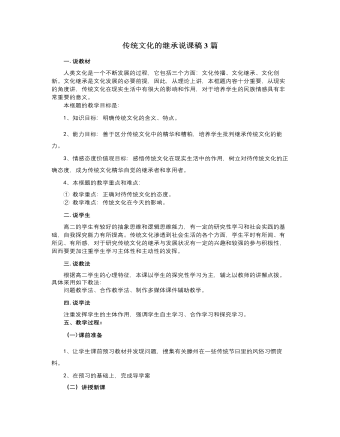
人教版高中政治必修3传统文化的继承说课稿3篇
(二)课堂教学在教学中,无论是形式还是内容,都必须统一于学生的发展。从形式上说,以学生展示、思考、讨论为主,教师点拨为辅,在一定的情境与社会文化背景下,获得对传统文化的认识和理解。从内容上说,主要以福州地方传统文化为素材,围绕海峡两岸同时举办的“元霄灯会”为主线,回归到学生的生活世界,更有效地激发起学生情感,并将生活世界与知识世界衔接起来,在实际情景中分析传授相关传统文化的知识,提高学生认识和分析解决问题的能力,逐步形成对传统文化的情感和价值判断。教学过程,紧紧围绕传统文化,分为“激趣导入--活动感悟--探究思辩--升华导行”四个层次,环环相扣,逐步推进,帮助学生完成由感性认识到理性认识的飞跃。1.激趣导入良好的开端是成功的一半。德国的普克朗认为:“思考可以构成一座桥,让我们通向新知识”。因此,一开始,我就运用对比方法,进行设问,福州和西安、南京、北京一样也是历史文化名城,你们同意吗?
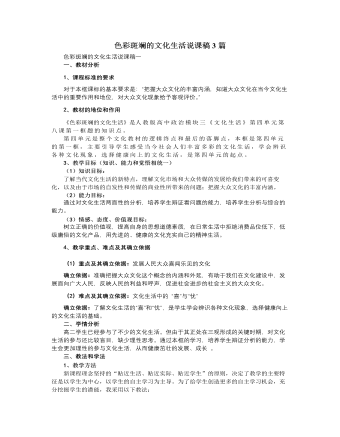
人教版高中政治必修3色彩斑斓的文化生活说课稿3篇
根据课标要求,参照教科书,支撑这一问题解决的知识有:⑴文化生活的特点;⑵文化生活的两面性;⑶发展文化生活的基本要求。其中重点问题是辨别文化生活的“喜”与“忧”。只有辨别清楚,才能趋利避害,才能积极主动的参与健康向上的文化生活。从而为怎样发展为人民大众所喜闻乐见的文化打下基础。由于高二学生尚未学习哲学知识,所以它也是本节的一个难点,同时,由于学术界对什么是大众文化,大众文化有那些基本特征,存在着分歧,所以正确把握大众文化的含义也成为本节课的一个难点。三、学情分析:应该说高二学生已经参与了不少的文化生活。但由于其正处在三观形成的关键时期,对文化生活的参与还比较盲目,缺少理性思考,以至付出沉重的代价。很显然通过本框的学习,学生会更加理性的参与文化生活,从而健康茁壮的发展、成长。四、教学目标:基于以上分析,我将本框题的教学目标确定为以下三个方面:(1)知识目标:了解目前我国文化生活的现状,知道人们的文化生活是色彩斑斓的,但也存在令人忧虑的现象;把握大众文化的丰富内涵;明确发展为人民大众所喜闻乐见的文化必须坚持的原则、方针等。





















